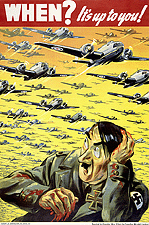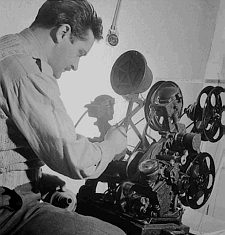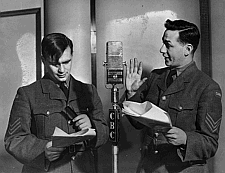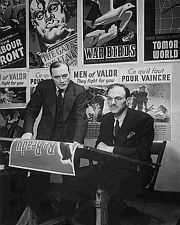|
COME BACK TO CANADA'S HOMEFRONT...
Roll back fifty years and more to see and hear the messages that mobilized Canadians
and sustained collective energies throughout the Second World War.
Victory Bonding, an exhibition of wartime communications produced by Canadian
government departments and agencies, draws on vivid archival treasures and our published
heritage to bring back memories of Canada's war years - to remember homefront efforts
along with sacrifices on the battlefields.
ENLIST!
BUY VICTORY BONDS!
SAVE, SALVAGE AND RECYCLE!
LET'S ALL PULL TOGETHER!
These are some of the messages that informed, encouraged and persuaded Canadians to
participate in a national undertaking in support of the Allied effort. Official wartime
communications took many forms ranging from standardized government directives to vibrant
commercial billboards designed to grab attention and to stir emotions. Their language,
visual styles and promotional strategies evoke the spirit of the times. Their recurring
sounds and images are a vital part of Canada's history and our collective memory of the
war years.

C-87518
|
Victory Bonding sets the government context for wartime communications -
identifying the departments sponsoring the campaigns, the production units and agencies,
and the creative talents of individuals. During the Second World War, public information
became entrenched as an essential government function, required to realize massive
national endeavours. public opinion polling techniques were used to determine needs and
strategies, new public service units were established to manage public information
initiatives, and the inventive skills of both government employees and private sector
companies and individuals were engaged to produce the artwork, texts, scripts, music, and
still and moving images. |
Now fifty years have passed. The retrospective vantage point of history permits us to
celebrate the hard-won victory, to assess the costly sacrifices, and even to admit to
errors and injustices. We can open once singular interpretations and dominant readings to
a new sensitivity that recognizes the multiplicity of views in a country as vast as
Canada. Now let us look at wartime messages through many eyes....
As we walk through the exhibition, or reflect upon its contents, let us imagine if from
the diverse perspectives of the many Canadians who experienced wartime
- a prime minister and his elected colleagues, responsible for a nation's affairs in such
time of stress, taking agonizing decisions that would be borne by all Canadians
- mothers, torn with pride and emotion, who embraced departing sons in uniform knowing
well that this might be the last time - and 42,042 Canadians lost their lives in
service never to return to a home coming embrace
- veterans, having suspended family and community life, careers and education, who came
back from the battlefront with physical disabilities and emotional scars - and 54,414
were counted among those who suffered injuries, and many more must have endured invisible
or uncounted wounds
- those who suffered loss of citizen rights, targeted as enemies on the basis of race or
nationality alone - including 21,000 Japanese-Canadians who were taken to internment
camps
- women who served in Canada's work force, responding to labour shortages that called on
them to adapt to new roles outside the home - over one million working women at the
peak of wartime employment - who, just as quickly, were expected to return to family
roles as war drew to a close
- those for whom this intense period meant new opportunities and experiences, including
those who came to serve Canada as public servants - from administrators to artists and
filmmakers
- as well as those joyous individuals who made up the crowds in 1945 in communities across
country celebrating
 PA-169536 PA-169536
 PA-129856 PA-129856

VICTORY
This lasting legacy of wartime messages serves to remind us of Canada's proud
contribution to the Allied effort. It also brings back a period when Canadians were
striving to articulate a collective and inclusive identity that would mark Canada's
maturity as a nation among nations.
 PA-152117 PA-152117
 PA-152119 PA-152119
CELEBRATE CANADA'S AUDIO-VISUAL HERITAGE
As we celebrate Canada's audio-visual heritage, and the centenary of cinema in
1995, this exhibition offers an appropriate occasion on which to acknowledge the
significant role that radio and film have played in Canada - particularly in the
government context. One of the agencies that flourished under the demands of wartime
communications was the National Film Board of Canada, established in 1939 to
consolidate and expand many of the activities of its predecessor, the Canadian Government
Motion Picture Bureau. Under the first Government Film Commissioner, John Grierson, the
NFB undertook an ambitious production and distribution program for films intended to serve
a public information and education function - striving to interpret Canada to Canadians
and to those abroad. These war years launched the documentary filmmaking tradition for
which Canadian filmmakers have been internationally recognized.
VICTORY BONDING
Wartime Messages from Canada's Government 1939-1945
This exhibition featured Second World War posters, films, photographs, artwork,
publications, ephemera and archival documents from government files preserved by the
National Archives of Canada including the Canadian Army Newsreels and films by the
National Film Board of Canada and sheet music and publications from the collections of the
National Library of Canada.
 PA-179108 PA-179108
 PA-166755 PA-166755
The exhibition was organized by the National Archives of Canada, in cooperation with the
National Film Board of Canada and the National Library of Canada with the generous support
of Glogalmic Design.
A NOTE TO RESEARCHERS
As the designated repository for the archival records of the federal government, the
National Archives of Canada preserves and extensive body of official documentation
relating to Canada's participation in the Second World War and makes this available to
researchers interested in studying this vast subject.
In addition to the records originally transferred from the Department of National
Defence and its service units, there are numerous other relevant groups of war records
such as those of the Privy Council Office; Parliament; the Departments of Munitions and
Supply, Finance, National War Services, and Veterans Affairs; as well as various Boards,
Offices and Commissions such as the Office of the Custodian of Enemy Property, the Wartime
Prices and Trade Board, the Wartime Information Board and the National Film Board.
While textual records predominate, government holdings exist in a range of other media
and formats - photographs, posters, films, radio broadcasts, original artwork, maps and
plans, ephemera, medals, philatelic and heraldic materials.
As well as federal government records, the National Archives of Canada also holds
archival collections from private sources. These include the personal papers of veterans,
politicians, community and business leaders, public servants, artists, and the
organizational records of non-government bodies that may contain information on the Second
World War.

|





